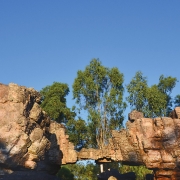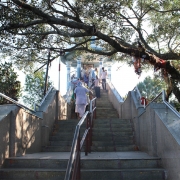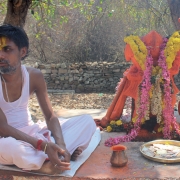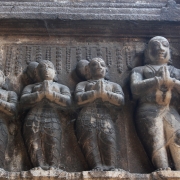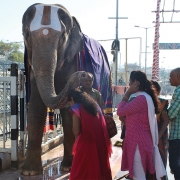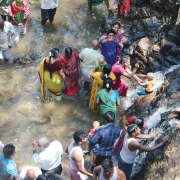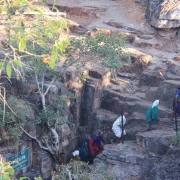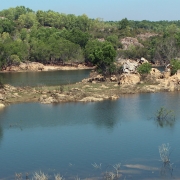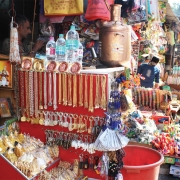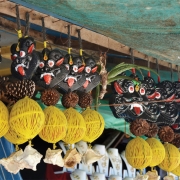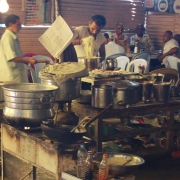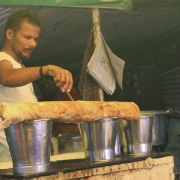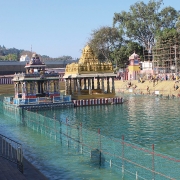
Etcetera
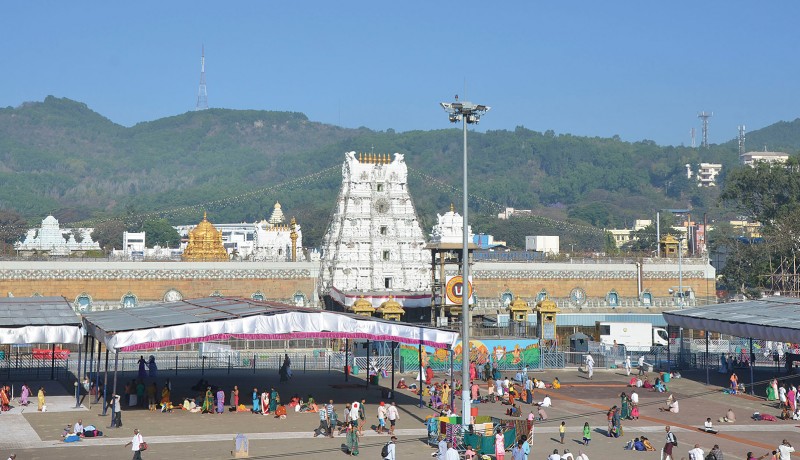
Tirupati’s claim to fame might be the sacred and spiritual, but it’s a veritable nature lover’s paradise
If it is a pilgrimage for the pious majority visiting it, for several others, Tirupati is a way of life. But the beauty of the spiritual capital of Andhra Pradesh, named the Best Heritage City by the Ministry of Tourism, extends far beyond its sanctity to encompass scenic vistas, wildlife havens, trekking paths and historical monuments to interest even the jaded traveller.
Tirupati, at the foot of Seshachalam hills, one of the several Indian cities to be developed under the Central Government’s smart cities mission, enjoys an ancient history. With seven prominent peaks, each with its distinct name, the Tirumala hills—also called upper Tirupati or Seshachalam, the mountain of Sesha, the divine serpent—appear like a coiled snake. On Venkatadri, the last and lowest of these peaks, lies the much revered temple of Lord Venkateshwara. The history of Tirumala can be traced to l5th century CE when it was an established Vaishnavite centre of learning. However, the deity of Lord Venkateshwara, a self-manifested one, is believed to be prehistoric in origin, and the central shrine is believed to have been built by the Greater Pallavas in 4th century BCE. Documented data attributes its construction in parts to several dynasties including the Pallavas, Cholas, Pandyas and the Vijayanagara rulers. The Varaha Purana mentions Lord Rama as having halted here with Sita and Lakshmana on his return from Lanka, in Treta Yuga.
My tryst with the temple city goes back several decades, perhaps as a young teen, when an annual or biannual visit to pay obeisance to the Lord of the hills would be a family ritual, or when weddings would be held there. For my siblings and I—Tamil Nadu-born but Delhi-bred—the bus journey uphill through the Eastern Ghats to Tirumala, negotiating several winding hairpin bends, was an unparalleled thrill. That which was a sanctimonious sojourn to the elders was a veritable picnic for us. We would indulge in the incendiary dishes of Andhra at the very few hotels in existence then, unmindful of our supremely active lachrymal glands and the tongues that would be on fire.
Since then, Tirupati’s allure as a potent panacea for people seeking solutions to any number and kinds of problems has increased manifold. Needless to say, the city pulsates with a sea of humanity any time of the year. Infrastructure-wise, it has taken giant leaps since my childhood and boasts several classy hotels, restaurants, boarding houses and lodges to suit every pocket. Our visits to the temple town, too, have undergone a change; piety has replaced the earlier picnic feel. While for a major part it still remains a family jaunt, we have added another dimension to these trips. Following the path of the devout pilgrim, we trek from the foothills to Tirumala via one of two scenic pathways: Alipiri and Srivari Mettu.
We begin our drive up to Tirupati from Bengaluru, where we reside, just before daybreak. We cover the 280-km distance motoring via the quaint Hoskote-Chintamani-Madanapalle route. The paved roads are flanked by endless stretches of lush fields that spring sunny marigolds and roses in hues of red and pink, besides other vegetation. Unlike the alternative route that takes us to Tirupati via Hoskote, Kolar and Chittoor, there are few eateries on our present course. But the verdure that stretches before us in this direction more than compensates for rumbling bellies that stay sated with the snacks we carry and cups of aromatic masala chai and coffee we gulp down at humble kiosks on the way.
At three, in the pre-dawn hour the following day, we begin our trek to the abode of Lord Venkateshwara from Alipiri, catching our breath now and then as we negotiate 3,550 steps, almost half being steep, in sections. There are several pilgrims of all ages and sizes who provide us company along the way, many chanting “Govinda, Govinda” to pep themselves up for the knee-jerking climb. As we huff and puff our way up, we learn from a fellow traveller that the Vaishnavite philosopher, saint and social reformer Ramanuja climbed these very hills on his knees! The entire pathway is dotted with small outlets providing refreshments and clean water.
The vistas that spread out before us are stunning. Nothing can exemplify better the charm of contrasting colours in nature than canopies of vibrant jacarandas and gulmohars as they blend gloriously with the trees that blanket the surrounding mountains. The boundless sky waltzes with flames above the horizon, signifying the emergence of dawn. The woods spring alive with the chirping of birds as they greet the emerging giant above. His first rays stream in through the gaps in the canopies, drawing curious patterns on our pathway. To add to the magical moments, we see several spotted deer frolicking in the lush forest park adjoining our stepped walkway.
The weather, which is salubrious for the most part of our way up, becomes a trifle weepy. Far above, tufts of light grey clouds begin to swirl with hypnotic slowness during the last stretch of our climb, and then the heavens break into a frenzied drizzle. As we continue our trudge up, we hear Suprabatham, the invocation to wake up the Lord, aired through speakers placed at various locations on the hill. This is followed by the continuous drone of mantras by priests at the temple. There is an incessant flow of vehicles making their way up the Tirumala hills. Public buses, many of them rickety, belch smoke as they jerk up for the steep hairpin ascent and trundle their way up the ghats, bringing pilgrims up in hordes. A little more than three hours and we reach our destination, Venkateshwara’s sacred dwelling; we feel we’ve peaked the Himalayas!
As we queue up for darshan, we see a fleet of buses come to a screeching halt; their doors fly open and eager devotees, clutching little and large cloth bags, fling themselves out in a frenzy and follow the route we’ve taken. The doors of the buses hiss themselves shut to begin yet another round trip. The atmosphere is festive, heightened by the religious fervour. The lanes and alleys leading to the temple are redolent with the heady scent of jasmine, roses and other fragrant flowers mixed with the palate-tickling aroma of smoking chulha, frying vadas, puris, giant masala dosas, chhaas and steaming hot milk and coffee. There are street artists and hawkers peddling their services and wares from little kiosks and umbrellas, shielding themselves from the vagaries of the weather.
As we’ve procured the ₹ 300 darshan ticket, our hour-long wait to have a minute’s glimpse of the Lord in all his grandeur comes to an end. The continuous chanting of Om Namo Venkatesaya inside the temple is mystically powerful, and exudes a positive energy that lingers after we leave the sanctum. Our minds and hearts sated at the success of our mission, we are now ready to explore the environs of Tirumala and Tirupati.
Silathoranam, meaning ‘a garland of rocks’, is a natural stone arch and a major crowd-puller to Tirumala’s verdant sculpture garden that displays the pantheon of deities, including Vishnu’s 10 incarnations, attractively carved and coloured. The fragrance of plants and trees in this expansive greenery is rejuvenating and a welcome change from the hum closer to the temple. The arch, a unique geological wonder, curves over two vertical columns of quartzite rocks, and has been sculpted by the vagaries of weather over 2.5 millennia. Folklore has it that the rocky marvel, located a kilometre away from the main temple, resembles important aspects of Hindu icons: the conch, discus and serpent hood; the last synonymous with Adi Sesha. The arch, which rises to a height of 3 m from the ground, shares this height with the idol of Lord Venkateshwara at the temple.
While theories abound on this unique formation, it is believed to be the only one in Asia, and one of three in the world—others being the Rainbow Arch Bridge of Utah in the USA and the arch that cuts through the Dalradian Quartzite in the UK. While some scientific quarters believe it could have been formed by a wave action from oceanic transgression or intensified climatic settings and corrosion, others attribute it to having been carved out of quartzite, or simply by weathering of the rock.
According to mythology, when Lord Venkateshwara first made his presence felt in the Tirumala hills, he set his first foot at its highest point, a place that came to be known as Srivari Paadalu, meaning divine footsteps. He then placed his other foot at the location of Silathorana. Following this, with a giant stride he stepped on to the place where his idol is now situated.
Next, we amble across to Chakratheertham against the backdrop of lush mountains. Alternating between rugged stone steps and flat uneven terrain, we weave our way between boulders to have spectacular views of a gentle waterfall that tumbles down to form this sacred pool. So named after the chakra or disc of Lord Vishnu, it glistens with coins, obviously thrown by devotees to have their wishes fulfilled. Legend has it that when Lord Brahma wished to perform penance, he sought Lord Vishnu’s help in identifying a pure location. When the Lord hurled his chakra, it sculpted a crater on the hill, creating the spot for Brahma to sit in meditation. Water from the hill streams rushed into this gorge to provide Brahma with water.
We head towards Srivari Paadalu, where a long flight of steps brings us to a small shrine that contains the feet of the Lord, encased in glass. Through a veil of mist and clouds that envelop our environs, we catch glimpses of the temple towers, mountain ranges and verdant valleys spread out below. It is evident, as elsewhere in Tirupati, that commercial interests have blended into the spiritual fabric of the place. Vendors selling an infinite variety of wares are everywhere, while youth armed with cameras beckon visitors to have their pictures clicked even as pilgrims scatter the place with coconuts they break with great gusto to the accompaniment of chants of “Govinda, Govinda”.
The clouds play peek-a-boo with the sun as we head towards Aakashaganga, with its fingers of waterfalls set amid dense woods. It is awash with colour and pulsating with bathers everywhere—in the rocky pools created by the aqueous deluge, on sinewy tree trunks that have branched out at comfortable heights to allow them to sit, and on the steps leading to the base of the falls. Water flows gently, caressing the randomly jutting rocks and boulders and tracing sinusoidal paths before it tumbles in a gush at several places, spreading like serpentine fingers of froth. I lose myself in the integrated harmony—the rocks, dense green woods, sky with tufts of clouds and deluge of water—this is virtual poetry exchanged between the forces of nature.
Besides being sought by a vast majority of pilgrims who come here to ‘wash away their sins’, Aakashaganga also supplies water for temple rituals. The tumbling water, which becomes a deluge during the monsoons, also finds mention in the Veda and has an interesting legend associated with it; it is believed to have originated from the feet of the deity. The Lord, in the guise of a fowler, is believed to have created the waterfall to facilitate his aged devotee Thirumala Nambi to access water for his daily rituals, instead of having to bring water from the Papavinasanam falls further away. Our curiosity is kindled as we make our way to the Gogarbham Dam and Papavinasanam falls. Rivulets of water flow from the hills to create the magical Papavinasam. Young hikers take the more adventurous rocky footpath to reach this serene beauty. Gogarbham Dam, one of the reservoirs that supply water to Tirumala township, is set scenically in the midst of green mountains. Little islands of green mounds ridden with shrubs and trees attract a host of winged visitors. An avian drama unfolds itself before us as the feathered creatures perform their unique acrobatics, soaring now, swooping down the next minute.
We brave a heavy downpour to reach Talakona falls, about 50 km from Tirupati. The thunderous avalanche tumbles down 270 ft, creating white jet sprays in its wake. A plethora of wild flowers and butterflies in motley hues abounds in the vicinity. The temples that dot Tirupati and its immediate neighbourhood are in themselves alluring, especially for art lovers. Traditional temple designs, from the profusion of sculpted deities in miniature or the flamboyant colours of etched Gods that adorn the gigantic tiered gopuram, engross every beholder.
Following a few days’ stay at Tirumala hills, we return to Tirupati town, taking the shorter but tougher 6-km route to Srivari Mettu foothills, which is entirely a stone-step pathway, steep in several places, making for more buckling knees!
Chandragiri Fort, 12 km from Tirupati on the Bengaluru route, is a befitting finale to our trip, which we saved for our return journey. The 11th century citadel was built by the Yadava Rayas who held sway over the region for three centuries before the Vijayanagara rulers took control. The fortress, which subsequently fell into the hands of the sultans of Golconda and then the rulers of Mysore, went into oblivion when it was abandoned in the final decade of the 18th century.
We are struck by the simplicity of the structures within the fort, very few of which are in a fairly reasonable state of preserve. The Raja Mahal or king’s palace now serves as a museum and displays artefacts collected from the fort precincts. Apart from the smaller Rani Mahal or queen’s palace, the fort contains a small lake and huge lawns, both of which apparently attract picnickers.
As the rotund star on the skies above prepares to retire, we are homeward bound, our mind and souls refreshed, not least from the spiritual sojourn as from the delights of nature itself, draped in myriad hues and shapes.
FACTFILE
GETTING THERE
By air: Tirupati has its own airport. Flights operate to and from major Indian metros and various cities of Andhra Pradesh and Telangana.
By rail: Tirupati railway station is the main railhead. Alternatively, one may travel up to Renigunta station, which is 15 km from Tirupati and lies on the Delhi–Thiruvananthapuram route.
By road: State transport buses ply between Tirupati and several Indian cities.
ACCOMMODATION
Tirupati has accommodations to suit all pockets, including guesthouses, serviced apartments, resorts and budget hotels.
TIPS
- Tirupati is a foodie’s delight. Andhra Spice, Hyderabad House, Minerva Coffee Shop and Maurya Restaurant offer gastronomic adventures. Sri Lakshmi Narayana Bhavan has plenty of options for vegetarians too.
- There are no private hotels in Tirumala. However, the Tirumala Tirupati Devasthana (TTD) has thousands of cottages and dormitories.
- There are several large choultries with free rooms for families to stay in reasonable comfort. Pilgrims may contact the central reception office near the bus stand in Tirumala for the same. Pilgrims can also rest in dormitory halls provided by TTD.
- TTD also has provisions for free shaving of hair and darshan for those who climb the hill. These free tickets are given midway up.
- For those who wish to spend a couple of days or more at Talakona waterfalls, Andhra Pradesh Tourism has jungle cottages at Haritha Resort.
Text: Chitra Ramaswamy Photos: J Ramaswamy Featured in Harmony — Celebrate Age Magazine August 2018
you may also like to read
-
Cracking the longevity code
Small yet impactful choices can be game-changers, writes Srirekha Pillai At 102, there’s no stopping Chandigarh-based Man Kaur, the world’s….
-
Home, not alone
While a regulatory framework is vital for senior-care facilities, the need of the hour is to develop an ecosystem to….
-
Birthday Girl
Published in a special edition to honour Japanese master storyteller Haruki Murakami’s 70th birthday, Birthday Girl (Penguin; Rs 100; 42….
-
A huge treat for music lovers
Published as the revised and updated second edition, Incomparable Sachin Dev Burman (Blue Pencil; Rs. 599; 470 pages) the authoritative….



